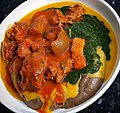Amala (food)

| This article is part of a series in |
| Culture of Nigeria |
|---|
 |
Àmàlà is a staple swallow food originating from Nigeria popularized by the Yoruba ethnic group of southwestern Nigeria and other parts of Yorubaland.[1] It is made of yam, cassava flour, or unripe plantain flour.[2] Tubers of yams are peeled, sliced, cleaned, dried and then ground into flour. It is also called èlùbọ́.[3] Yams are white in colour but turn brown when dried which gives àmàlà its colour.[4][5] It is a popular side dish served with ewédú[6] and gbẹ̀gìrì (black-eyed beans soup), but is also served with a variety of other ọbè (soups), such as ẹ̀fọ́,[7] ilá, and ogbono.[8][9][10]
Types
[edit]There are three types of àmàlà: àmàlà isu,[11] àmàlà láfún, and amala ògèdè.[12]
Yam flour (àmàlà isu)
[edit]Àmàlà isu, the most common type of àmàlà, is yam-based. The particular yam species best for preparing àmàlà is Dioscorea cayenensis (Ikoro) because of its high starch content.[13] Because of its perishability, yam is often dried and made into flour. The flour can then be reconstituted with hot water to form a paste or gel called kokonte in Ghana and Togo, and àmàlà in Nigeria.[14][15] Àmàlà isu is made of dried yam. This gives it a black/brownish colour when added to boiling water.[16][17] Amala is rich in carbohydrates and is an important source of carbohydrate, especially in the yam zone of West Africa.[18][19][20]
Àmàlà láfún is made from cassava flour.[21] Dried cassava flour is known as lafun in Nigeria and konkonte in Ghana.[22][23][24]
Another type of amala is elubo ogede, which is usually lighter in color. The low carbohydrate level in plantain flour makes it suitable for diabetics. Unripe plantain is peeled, dried, and grated into boiling water, creating a light brown paste when cooked.[25][26]
Soups
[edit]Àmàlà can be eaten with various soups:
- Efo riro: made from vegetables and a mixture of meat, fish, cow skin (ponmo), and other meats[27]
- Egusi: soup made of thickened melon seeds and leaf vegetables.[28][29]
- Ewedu soup: made from cooked and grated Corchorus leaves with or without a small quantity of egusi and/or locust beans.[30]
- Gbegiri Soup:[31] made from dried beans.[32]
- Okro soup: made from okra.[33]
- Ogbono soup: made from ground ogbono seeds and a mixture of palm oil, stock fish and locust beans (irú) added as garnish.[34]
Gallery
[edit]-
Amala
-
Amala and gbegiri with ewedu soup
-
Group of women kneading amala
See also
[edit]References
[edit]- ^ Roots, Tubers, Plantains and Bananas in Human Nutrition. Rome: Food and Agriculture Organization of the United Nations. 1990. p. 68. ISBN 9789251028629.
- ^ Ferris, R. S. B.; Uwaegbute A. C.; Osho S. M.; Obatolu V. A. (1995). "Acceptability and chemical evaluation of fortified yam (Discorea spp.) products". Postharvest Technology and Commodity Marketing: Proceedings of a Postharvest Conference 2 Nov. To 1 Dec. 1995. Accra, Ghana: 172. ISBN 978-978-131-111-6.
- ^ "YAM FLOUR PRODUCTION (ELUBO)". Foodpreneurs Hub. 2018-08-04. Retrieved 2022-07-27.
- ^ Balogh, Esther (1989). "History and perspectives of stable foods in Africa". Oxford Symposium on Food & Cookery. p. 51. ISBN 9780907325444.
- ^ Dumont, Roland (2006). Biodiversity and Domestication of Yams in West Africa: Traditional Practices Leading to Dioscorea Rotundata Poir. Editions Quae. p. 28. ISBN 9782876146327.
- ^ Ajoke (2021-05-30). "Ewedu Soup". My Active Kitchen. Retrieved 2022-12-12.
- ^ Ajoke (2019-06-04). "How to Make Efo Riro". My Active Kitchen. Retrieved 2022-12-12.
- ^ "How to Prepare Okro Soup (Obe ila)". Habeeb Olonje. 2018-09-05. Archived from the original on 2019-06-03. Retrieved 2019-06-03.
- ^ "Best soups to eat D-Amala with". Retrieved 2022-05-10.
- ^ "Amala and Ewedu Soup Recipe". Chef's Pencil. Retrieved 2022-05-10.
- ^ "How Elubo is Made – Yam Flour (Amala-Isu) – Abebi Foods". Retrieved 2022-12-12.
- ^ "Amala Food Recipe | How to Cook Amala - African Food Network". 2017-04-09. Retrieved 2022-05-10.
- ^ "YAM FLOUR PRODUCTION (ELUBO)". Foodpreneurs Hub. 2018-08-04. Retrieved 2022-07-27.
- ^ Jimoh, O.; Olatidoye, O. P. (2009). "Evaluation of physicochemical and theological characteristics of soybean fortified yam flour". Journal of Applied Biosciences. 13: 703–704 – via Researchgate.
- ^ "Kokonte | Traditional Stew From Ghana | TasteAtlas". www.tasteatlas.com. Retrieved 2022-05-10.
- ^ Ago, Phunkein #nigeria • 5 Years (2017-08-11). "Amala". Steemit. Retrieved 2022-05-10.
{{cite web}}: CS1 maint: numeric names: authors list (link) - ^ "How Elubo is Made – Yam Flour (Amala-Isu) – Abebi Foods". Retrieved 2022-05-10.
- ^ Akissoe, N. H.; Hounhouigan, J. D.; Brica, .W.; Vernier, P.; Nago, M. C.; Olorunda, O. A. (2003). "Physical, chemical and sensory evaluation of dried yam (Dioscorea rotundata) tubers, flour and amala- a flour-derived product". Journal of Tropical Science. 41: 151–156 – via Google Scholar.
- ^ "What is the English of Amala? – Firstlawcomic". firstlawcomic.com. Retrieved 2022-05-10.[permanent dead link]
- ^ "How to make the perfect "Amala"". Vanguard News. 2016-10-10. Retrieved 2022-05-10.
- ^ Nwokolo, Collins (2021-03-01). "10 Amazing Health Benefits Of Amala". Health Guide NG. Retrieved 2022-05-10.
- ^ "5 Popular Swallows Eaten By Ghanaians". Modern Ghana. Retrieved 2022-05-03.
- ^ "How To Prepare Kokonte » My Recipe Joint". Retrieved 2022-05-10.
- ^ "Konkonte | Traditional Side Dish From Ghana | TasteAtlas". www.tasteatlas.com. Retrieved 2022-07-27.
- ^ "Plantain Fufu (Amala Ogede) Recipe :: Nigerian Dishes :: Galleria Health and Lifestyle, Nigeria". www.nigeriagalleria.com. Retrieved 2022-05-10.
- ^ Sue (2015-08-02). "How to Make Plantain Flour". Backcountry Paleo. Retrieved 2022-05-10.
- ^ Rees, D.; Farell, G. & Orchard, J. (2012). Crop Post-Harvest: Science and Technology, Perishables. Hoboken: John Wiley & Sons. p. 408.
- ^ Evans, Diana (2020-02-17). "Nigerian Egusi Soup". Precious Core. Retrieved 2022-05-10.
- ^ Lete, Nky Lily (2013-06-25). "Nigerian Egusi Soup - Obe Efo elegusi : How to cook Egusi Soup". Nigerian Food TV. Retrieved 2022-05-10.
- ^ "5 Soups You Should Try With 'The King Of Swallows'". BizWatchNigeria.Ng. 2022-05-03. Retrieved 2022-05-10.
- ^ Nwosu Chukwuebuka (2023-08-23). "8 Notable Health Benefits of Gbegiri Soup". NccMed. Retrieved 2023-08-23.
- ^ "Gbegiri - Abula (How to make Gbegiri)". My Active Kitchen. 2020-03-01. Retrieved 2022-05-10.
- ^ "Okro Soup (African Okra Soup)". Low Carb Africa. 2019-07-20. Retrieved 2022-05-10.
- ^ Lete, Nky Lily (2012-09-21). "Ogbono Soup Recipe:How to Cook Ogbono Soup (draw soup)". Nigerian Food TV. Retrieved 2022-05-10.
External links
[edit]![]() Media related to Amala at Wikimedia Commons
Media related to Amala at Wikimedia Commons



